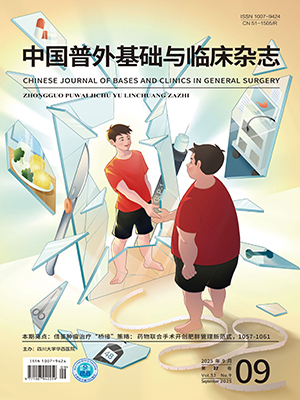| 1. |
Gamaleldin M, Church JM, Stocchi L, et al. Is routine use of adjuvant chemotherapy for rectal cancer with complete pathological response justified? Am J Surg, 2017, 213(3): 478-483.
|
| 2. |
Koyama M, Kitazawa M, Ehara T, et al. Two cases of Fournier’s gangrene that occurred during chemotherapy for rectal cancer. Gan To Kagaku Ryoho, 2017, 44(2): 169-171.
|
| 3. |
Sauer R, Becker H, Hohenberger W, et al. Preoperative versus postoperative chemoradiotherapy for rectal cancer. N Engl J Med, 2004, 351(17): 1731-1740.
|
| 4. |
Dellas K, Buller J, Görtz GJ, et al. Analysis of bevacizumab-based preoperative radiochemotherapy in patients with locally advanced rectal cancer on surgery-associated spectrum of complications. Ann Surg Oncol, 2014, 21(4): 1352-1360.
|
| 5. |
Bosset JF, Calais G, Mineur L, et al. Fluorouracil-based adjuvant chemotherapy after preoperative chemoradiotherapy in rectal cancer: long-term results of the EORTC 22921 randomised study. Lancet Oncol, 2014, 15(2): 184-190.
|
| 6. |
Rotovnik Kozjek N, Kompan L, Žagar T, et al. Influence of enteral glutamine on inflammatory and hormonal response in patients with rectal cancer during preoperative radiochemotherapy. Eur J Clin Nutr, 2017, 71(5): 671-673.
|
| 7. |
中华医学会外科学分会胃肠外科学组, 中华医学会外科学分会结直肠肛门外科学组, 中国抗癌协会大肠癌专业委员会, 等. 结直肠癌肝转移诊断和综合治疗指南(V 2013). 中华胃肠外科杂志, 2013,16(8): 780-788.
|
| 8. |
Eisenhauer EA, Therasse P, Bogaerts J, et al. New response evaluation criteria in solid tumours: revised RECIST guideline (version 1.1). Eur J Cancer, 2009, 45(2): 228-247.
|
| 9. |
Supaadirek C, Pesee M, Thamronganantasakul K, et al. Outcomes of preoperative chemoradiotherapy and combined chemotherapy with radiotherapy without surgery for locally advanced rectal cancer. Asian Pac J Cancer Prev, 2016, 17(7): 3511-3514.
|
| 10. |
Heald RJ. Total mesorectal excision is optimal surgery for rectal cancer: a Scandinavian consensus. Br J Surg, 1995, 82(10): 1297-1299.
|
| 11. |
杨明丽, 牛楠. Ⅱ至Ⅲ期中低位直肠癌术前同步放化疗的临床疗效分析. 结直场肛门外科, 2016, 22(S2): 1-4.
|
| 12. |
林培煜. 术前新辅助同步放化疗治疗Ⅱ、Ⅲ期直肠癌疗效的 Meta 分析. 广西医学, 2016, 38(4): 506-510.
|
| 13. |
张杰, 郭媛, 闫旭升, 等. 中低位Ⅱ/Ⅲ期直肠癌术前辅助同步放化疗的效果分析. 中国现代医生, 2017, 55(7): 71-74.
|
| 14. |
González-González M, Garcia J, Alcazar JA, et al. Association between the cytogenetic profile of tumor cells and response to preoperative radiochemotherapy in locally advanced rectal cancer. Medicine (Baltimore), 2014, 93(26): e153.
|
| 15. |
Sebag-Montefiore D, Stephens RJ, Steele R, et al. Preoperative radiotherapy versus selective postoperative chemoradiotherapy in patients with rectal cancer (MRC CR07 and NCIC-CTG C016): a multicentre, randomised trial. Lancet, 2009, 373(9666): 811-820.
|
| 16. |
Roh MS, Colangelo LH, O’Connell MJ, et al. Preoperative multimodality therapy improves disease-free survival in patients with carcinoma of the rectum: NSABP R-03. J Clin Oncol, 2009, 27(31): 5124-5130.
|
| 17. |
Gomez-Millan J, Queipo MI, Del Mar Delgado M, et al. The impact of body mass index and nuclear β-catenin on survival in locally advanced rectal cancer treated with preoperative radiochemotherapy. J Surg Oncol, 2017, 115(3): 301-306.
|
| 18. |
Bohanes P, Rankin CJ, Blanke CD, et al. Pharmacogenetic analysis of INT 0144 trial: association of polymorphisms with survival and toxicity in rectal cancer patients treated with 5-FU and radiation. Clin Cancer Res, 2015, 21(7): 1583-1590.
|
| 19. |
Bendell JC, Thompson D, Hemphill BM, et al. A phase 2 study of 5-fluorouracil (5-FU), ziv-aflibercept, and radiation for the preoperative and adjuvant treatment of patients with stage Ⅱ/Ⅲ rectal cancer. Cancer Invest, 2017, 9: 1-6.
|
| 20. |
Gani C, Schroeder C, Heinrich V, et al. Long-term local control and survival after preoperative radiochemotherapy in combination with deep regional hyperthermia in locally advanced rectal cancer. Int J Hyperthermia, 2016, 32(2): 187-192.
|
| 21. |
金珊, 谭诗, 生李杭, 等. 术前同步放化疗联合全直肠系膜切除术治疗中低位局部晚期直肠癌的疗效. 中国肿瘤临床与康复, 2015, 22(7): 824-826.
|
| 22. |
De Felice F, Benevento I, Magnante AL, et al. Clinical benefit of adding oxaliplatin to standard neoadjuvant chemoradiotherapy in locally advanced rectal cancer: a meta-analysis: Oxaliplatin in neoadjuvant treatment for rectal cancer. BMC Cancer, 2017, 17(1): 325.
|
| 23. |
Kotake M, Aoyama T, Munemoto Y, et al. Multicenter phase Ⅱ study of infusional 5-fluorouracil (5-FU), leucovorin, and oxaliplatin, plus biweekly cetuximab as first-line treatment in patients with metastatic colorectal cancer (CELINE trial). Oncol Lett, 2017, 13(2): 747-753.
|
| 24. |
Bakke KM, Hole KH, Dueland S, et al. Diffusion-weighted magnetic resonance imaging of rectal cancer: tumour volume and perfusion fraction predict chemoradiotherapy response and survival. Acta Oncol, 2017, 56(6): 813-818.
|
| 25. |
Fukui T, Suzuki K, Ichida K, et al. Sequential administration of XELOX and XELIRI is effective, feasible and well tolerated by patients with metastatic colorectal cancer. Oncol Lett, 2017, 13(6): 4947-4952.
|
| 26. |
郑虹, 黄勇. 术后放疗同步 FOLFOX4 和 XELOX 化疗方案治疗Ⅱ/Ⅲ期直肠癌的临床比较. 贵州医药, 2017, 41(3): 255-258.
|
| 27. |
Ohta H, Hayashi T, Murai S, et al. Comparison between hypersensitivity reactions to cycles of modified FOLFOX6 and XELOX therapies in patients with colorectal cancer. Cancer Chemother Pharmacol, 2017, 79(5): 1021-1029.
|
| 28. |
黄芳, 刘超英. FOLFOX4 方案与 XELOX 方案治疗转移性结直肠癌的疗效与不良反应分析. 实用癌症杂志, 2016, 31(10): 1675-1677.
|
| 29. |
Pilancı KN, Saglam S, Okyar A, et al. Chronomodulated oxaliplatin plus capecitabine (XELOX) as a first line chemotherapy in metastatic colorectal cancer: A phase Ⅱ Brunch regimen study. Cancer Chemother Pharmacol, 2016, 78(1): 143-150.
|
| 30. |
Ogata Y, Shimokawa M, Tanaka T, et al. A prospective study of XELOX plus bevacizumab as first-line therapy in Japanese patients with metastatic colorectal cancer (KSCC 0902). Int J Clin Oncol, 2016, 21(2): 335-343.
|
| 31. |
Clarke TL, White DA, Osborne ME, et al. Predicting response to neoadjuvant chemoradiotherapy in locally advanced rectal cancer with serum biomarkers. Ann R Coll Surg Engl, 2017, 99(5): 373-377.
|




